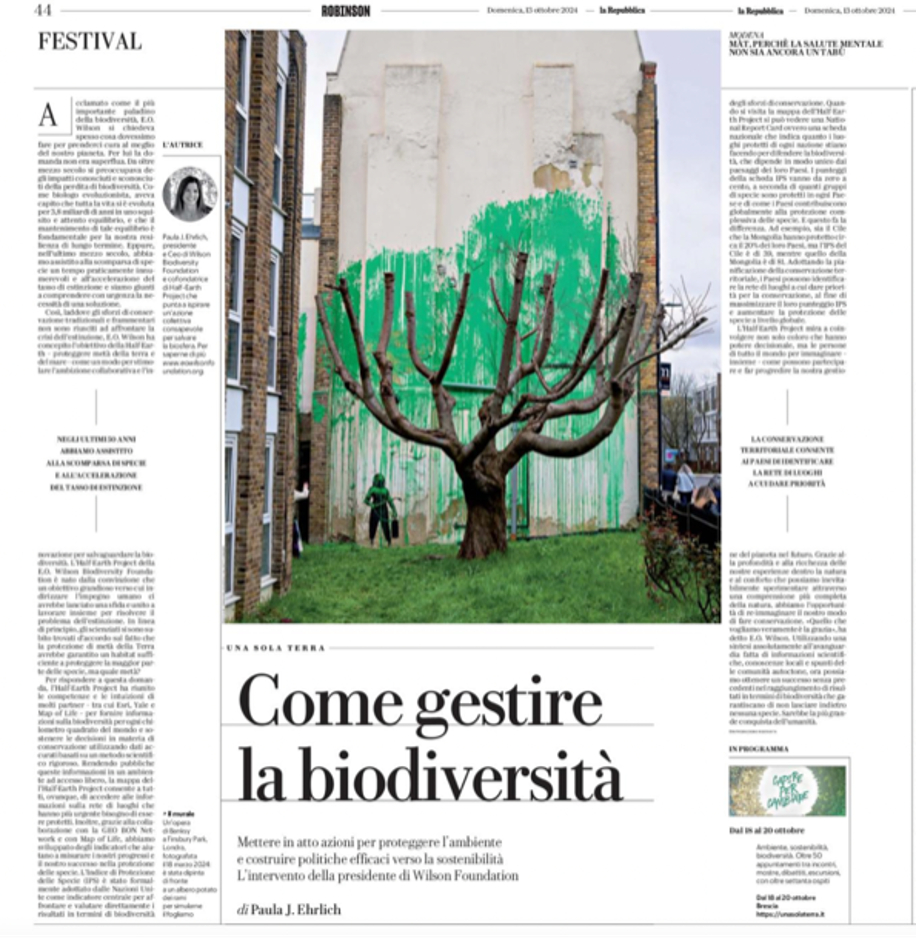The Italian newspaper, La Repubblica, has featured a publication by Paula J. Ehrlich, President & CEO of the E.O. Wilson Biodiversity Foundation, in its Sunday supplement, Robinson-La Repubblica. The publication appeared in association with the Only One Earth festival, October 18-20, in Brescia, Italy. The festival will open with the E.O. Wilson Biodiversity Foundation’s video, Saving Biodiversity: The Next Big Thing, in which Dr. Ehrlich and E.O. Wilson discuss the importance and inspiration of the Foundation’s Half-Earth Project.


The article, titled “How to manage biodiversity,” highlights the need to implement actions to protect the environment and build effective policies towards sustainability. An English translation of the Italian print publication, appears below:
Hailed as the pre-eminent champion of biodiversity, E.O. Wilson was often asked what we needed to do to best care for our planet. The question wasn’t an idle one for him. He had been concerned about the known and unknown impacts of biodiversity loss for over half a century. As an evolutionary biologist, he understood that all of life has evolved over 3.8 billion years in an exquisite, careful balance, and that maintaining that balance is critical to our enduring resilience. Yet in the past half-century, we have watched species that were once virtually innumerable practically disappear from the Earth and seen the rate of extinction accelerate. We’ve come to urgently understand the need for a solution.
So where traditional, piecemeal conservation efforts had fallen short in addressing the extinction crisis, E.O. Wilson conceived of the goal of Half-Earth – protecting half the land and sea – as a way of driving collaborative ambition and innovation to safeguard biodiversity. The E.O. Wilson Biodiversity Foundation’s Half-Earth Project was borne out of the sense that a moonshot goal of human endeavor would challenge and unite us to work together to solve the problem of extinction. In principle, scientists immediately agreed that protecting half the Earth would secure sufficient habitat to protect most species, but which half?
– Over the last 50 years we have witnessed the disappearance of species and the acceleration of the rate of extinction –
To answer that question, the Half-Earth Project has convened the expertise and insights of many partners – including Esri, Yale and the Map of Life – to provide biodiversity insights for any square kilometer in the world and support conservation decisions using accurate data grounded in rigorous science. By democratizing this information in an open access environment, the Half-Earth Project Map allows everyone everywhere access to information about the network of places that most urgently need protection. Importantly – and through collaboration with the GEO BON Network and Map of Life – we have developed indicators that also help measure our progress and success in protecting species. The Species Protection Index (SPI) has now been formally adopted by the United Nations as the central indicator for directly addressing and reporting on the biodiversity outcomes of conservation efforts.
When you visit the Half-Earth Project Map, you can see a National Report Card for how well the protected places of every nation are doing in protecting the biodiversity that uniquely depends upon the landscapes of their countries. Report Card SPI scores range from zero to 100 depending upon how many species groups are protected in each country and how they contribute globally to overall species protection.
And this makes a difference. For example, both Chile and Mongolia have protected about 20 percent of their countries, but Chile’s SPI is 39 while Mongolia’s SPI is 81. By embracing spatial conservation planning, countries can identify the network of places they should prioritize for conservation to maximize their SPI score and increase global species protection. The further integration of Indigenous and local community insights into this Commons forum of understanding further ensures successful stewardship of the places that are most critical for biodiversity and the people who call those places home.
– Territorial conservation allows countries to identify the network of priority places –
The Half-Earth Project aims to engage – not just decision-makers – but people everywhere to imagine, together, how they can participate and advance our stewardship of the planet into the future. Through the wholeness and richness of our experiences in nature and the comfort we can inevitably experience through a fuller understanding of nature we have the opportunity to reimagine how we do conservation. “What we really want is grace,” E.O. Wilson once said. Using cutting-edge synthesis of scientific information, local knowledge and community insights we can now realize unprecedented success in achieving biodiversity outcomes that ensure we leave no species behind. It would be humanity’s greatest achievement.
The Author
Paula J. Ehrlich, President & CEO of the E.O. Wilson Biodiversity Foundation and co-Founder of the Half-Earth Project, which aims to inspire conscious collective action to save the biosphere. Read more www.eowilsonfoundation.org

